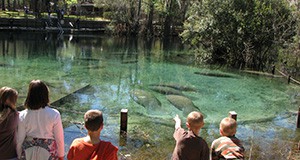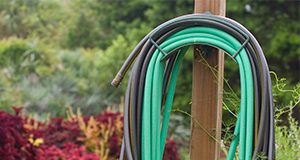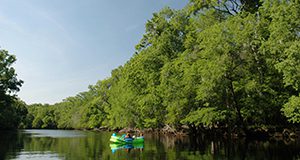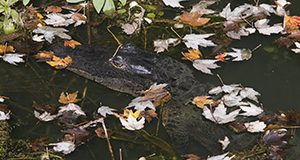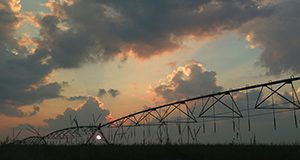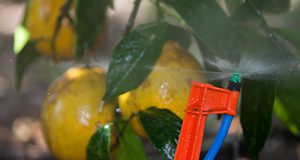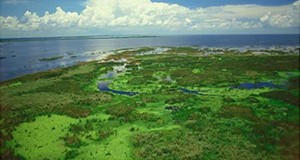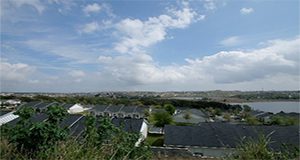Recreation is only one of the benefits people receive from water resources. Water is essential for fisheries and aquaculture, for drinking and bathing, for sanitation, and for spiritual and symbolic purposes, among myriad other uses described in the Economic Value of Florida Water Resources series. This 6-page fact sheet written by Tatiana Borisova, Kurt Oehlbeck, Xiang Bi, Tara Wade, Alan Hodges, Kelly Grogan, and Fe Hei and published by the UF/IFAS is the second part of the series. It discusses the contribution of water-based tourism to the economy in various Florida regions, summarizing a number of economic studies and focusing on freshwater-based recreation, such as canoeing, freshwater angling, wildlife watching, lake- or river-shore hiking, spring diving, and more. Readers can pick and choose the studies most relevant to their geographic area or their area of interest.
https://edis.ifas.ufl.edu/fe1065
Tag: Tatiana Borisova
Valuing Florida Water Resources: Households’ Willingness to Pay for Water
This 8-page fact sheet written by Tatiana Borisova, Fei He, Xiang Bi, Kelly Grogan, Tara Wade, and Syed Shah and published by the UF/IFAS Food and Resource Economics Department reviews various methods of examining the value of water availability for household needs. It may be helpful to water resource managers planning investments in water infrastructure to prepare for droughts as well as for analyzing spending on protecting source water availability, for example, by protection of aquifers or increasing the recharge of aquifers, the primary water source in Florida.
http://edis.ifas.ufl.edu/fe1068
Economic Value of Florida Water Resources: Value of Freshwater-Based Recreational Experiences
This 8-page fact sheet written by Tatiana Borisova, Tara Wade, Xiang Bi, Kurt Oehlbeck, and Kelly Grogan and published by the UF/IFAS Food and Resource Economics Department is part 3 of the series “Economic Value of Florida Water Resources.” It uses Florida-based economic studies to provide natural resource professionals and interested citizens with information regarding the value of water-based tourism and recreation in Florida.
http://edis.ifas.ufl.edu/fe1067
Valuing Florida’s Water Resources: Ecosystem Services Approach
This 6-page fact sheet written by Tatiana Borisova, Tara Wade, Xiang Bi, Kurt Oehlbeck, and Kelly Grogan and published by the UF/IFAS Food and Resource Economics Department defines the term “ecosystem services” and presents examples of ecosystem services provided by water resources. It explains three values people assign to water resources and presents a brief overview of the methods that economists employ to measure the value of water.
http://edis.ifas.ufl.edu/fe1064
Valuing Florida Water Resources: Prices of Waterfront Properties
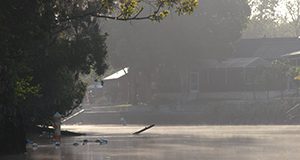
This 9-page fact sheet written by Tatiana Borisova, Xiang Bi, Tara Wade, and Kurt Oehlbeck and published by the UF/IFAS Food and Resource Economics Department explores the relationship between water quality and sale prices of waterfront properties, that is, the amenity value provided by water resources to waterfront communities. Being near to water to water generally increases the value of a residential property. However, poor water quality may decrease waterfront property prices. In other words, investments in restoring water quality can translate into increases in property value and tax collection.
http://edis.ifas.ufl.edu/fe1062/p>
Economic Value of Florida Water Resources: Valuing the Quality of Water for Household Needs
Florida water-resource professionals deciding whether to implement a costly water protection program or to invest in better tap water treatment technology may wonder: Are such investments justified? What are the benefits of the program or investment decision? Just how highly do Floridians value their water? This 5-page fact sheet written by Tatiana Borisova, Syed Irfan Ali Shah, Tara Wade, Xiang Bi, and Kelly Grogan and published by the UF/IFAS Food and Resource Economics Department reviews studies that help assess the value Floridians assign to maintaining or improving the quality of the water supply.
http://edis.ifas.ufl.edu/fe1059
Valuing Florida Water Resources: Water Use in Irrigated Agriculture
Water resources provide us with a variety of goods and services (altogether often referred to as ecosystem services or environmental services.) Part of a series entitled Economic Value of Florida Water Resources, this 5-page fact sheet written by Tatiana Borisova, Syed Irfan Ali Shah, Tara Wade, Kelly Grogan, and Xiang Bi and published by the UF/IFAS Food and Resource Economics Department assesses the economic value of the ecosystem services provided by irrigation water and shows the importance to agriculture of water resource protection and restoration.
http:edis.ifas.ufl.edu/fe1057
Manual de los Reglamentos del Agua de Florida: Ley de Protección de Acuíferos y Manantiales
La Ley del Agua de Florida de 2016, una política integral de agua que aborda los problemas críticos del suministro y la calidad de agua en la Florida, entró en vigor el 1 de julio de 2016. Creó la Ley de Protección de Acuíferos y Manantiales de Florida, que protege los manantiales alimentados por el acuífero floridano. Written by Michael Olexa, Tatiana Borisova, and Jarrett Davis and published by the UF/IFAS Food and Resource Economics Department.
http://edis.ifas.ufl.edu/fe1047
Los recursos hidricos de Florida
Tatiana Borisova y Tara Wade, Departamento de Economia de Alimentos y Recursos, UF/IFAS. This is the Spanish translation of “Florida’s Water Resources,” available in English here.
http://edis.ifas.ufl.edu/fe1044
Blueberry Frost Protection Practices in Florida and Georgia

Written by Tatiana Borisova, Elizabeth Conlan, Erick Smith, Mercy Olmstead, and Jeffrey Williamson and published by the UF/IFAS Food and Resource Economics Department, this publication was developed to assist professionals attempting to establish a benchmark for when to use frost protection in blueberry production. This benchmark can assist in developing outreach strategies to educate producers about frost protection strategies, and it can also help measure changes in their frost protection behavior over time.
http://edis.ifas.ufl.edu/fe1045
An Overview of Florida Water Policy Framework and Institutions
Written by Jarrett Davis, Tatiana Borisova, and Michael T. Olexa and published by the UF/IFAS Food and Resource Economics Department, this publication provides a background on the history of laws and regulations governing water use in Florida and an overview of those laws.
edis.ifas.ufl.edu/fe1043
Handbook of Florida Water Regulation: 2016 Florida Water Bill
This handbook is designed to provide an accurate, current, and authoritative summary of the principal federal and state laws that directly or indirectly relate to agriculture. Written by Tatiana Borisova, Michael T. Olexa, and Jarrett Davis and published by the UF/IFAS Food and Resource Economics Department, this chapter of the handbook provides a basic overview of the Florida Water Bill.
http://edis.ifas.ufl.edu/fe1018
Handbook of Florida Water Regulation: Florida Springs and Aquifer Protection Act
This handbook is designed to provide an accurate, current, and authoritative summary of the principal federal and state laws that directly or indirectly relate to agriculture. Written by Tatiana Borisova, Michael T. Olexa, and Jarrett Davis and published by the UF/IFAS Food and Resource Economics Department, this chapter of the handbook provides a basic overview of the Florida Springs and Aquifer Protection Act.
http://edis.ifas.ufl.edu/fe1019
Handbook of Florida Water Regulation: Soil and Water Conservation Districts
This 2-page fact sheet written by Michael T. Olexa, Tatiana Borisova, and Jarrett Davis and published by the UF/IFAS Food and Resource Economics Department is part of a handbook designed to provide an accurate, current, and authoritative summary of the principal federal and Florida state laws that govern agriculture. This chapter provides an overview of soil and water conservation districts (SWCDs), explains their purpose and structure, and describes some of the agency partnerships SWCDs make.
edis.ifas.ufl.edu/fe1017
Collaborative Planning for the Future of Water Resources in Central Florida: Central Florida Water Initiative
Rules and regulations that govern our use of natural resources, specifically water, are changing. Over the past 80 years, Florida’s population increased four times, from approximately 5 million to more than 20 million people. With this population increase, water needs have also increased. Forward-looking communities think about the future of their towns, counties, or the state as they work on redefining regulations to meet future water needs without harming our springs, lakes, rivers, and estuaries. This 4-page fact sheet written by James Fletcher and Tatiana Borisova and published by the Food and Resource Economics Department discusses the Central Florida Water Initiative, which deals with advancing water-use and water-resource-protection strategies for Orlando and its vicinity.
http://edis.ifas.ufl.edu/fe1012
Estimating Benefits of Residential Outdoor Water Conservation: A Step-by-Step Guide
This 9-page fact sheet written by Tatiana Borisova, Laura A. Warner, Jennison Searcy, Anil Kumar Chaudhary, and Michael Dukes and published by the UF Department of Food and Resource Economics in February 2017 was developed to help Extension agents, water-conservation managers, and homeowners estimate the economic benefits of residential outdoor water conservation. It provides guidance for reporting benefits, including lowered utility bills for homeowners, reduced water-delivery costs for utilities, and increased water supply. This publication also offers an example of an impact statement.
http://edis.ifas.ufl.edu/fe1009
Frost Protection Irrigation for Florida Peaches: Economic Considerations
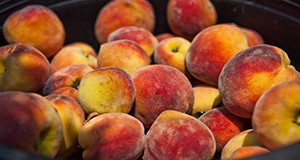
Peach production in Florida is increasing in importance, and the peach industry is growing rapidly in the state, where the early harvest and early market window allow the prices for Florida peaches to be high compared to those received by producers in the other southeastern states. Reduction in peach production costs would allow Florida peach producers to increase their net revenues. This 7-page fact sheet describes a strategy for limiting water use for frost protection of peach trees in the winter to reduce producers’ costs, protect lakes and streams, and reinforce the public image of farmers as innovators and environmental stewards. Written by Tori Bradley, Tatiana Borisova, and Mercy Olmstead and published by the Food and Resource Economics Department.
edis.ifas.ufl.edu/fe980
Improving the Precision of Blueberry Frost Protection Irrigation
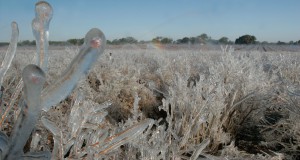
In Florida, early-ripening southern highbush blueberry cultivars allow growers to take advantage of high prices in the early market before other states can compete with higher volumes of berries sold at lower prices. That advantage comes with a vulnerability, however, because frosts can reduce gains. Florida growers rely on strategies like cold protection irrigation to reduce their risk of loss due to cold damage. This 9-page article by Tatiana Borisova, Tori Bradley, Mercy Olmstead, and Jeffrey Williamson describes a UF/IFAS study comparing precision cold protection irrigation to uniform cold protection irrigation to estimate the potential savings in diesel costs and water withdrawal volumes associated with the two practices and help protect Florida’s valuable and vulnerable blueberry harvest. Published by the Food and Resource Economics Department in November 2015.
http://edis.ifas.ufl.edu/fe979
Economic Contributions and Ecosystem Services of Springs in the Lower Suwannee and Santa Fe River Basins of North-Central Florida
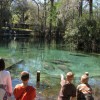 This study examined the economic contributions, consumer surplus, and ecosystem services provided by recreational use of fifteen major springs sites in north central Florida. The estimated annual economic contributions of springs-related recreational spending in north-central Florida for FY 2012/13 are summarized. Among the findings, there was $84.2 million in total visitor spending for springs recreation, and 1,160 full- and part-time jobs. This 4-page fact sheet was written by Tatiana Borisova, Alan W. Hodges, and Thomas J. Stevens, and published by the UF Department of Food and Resource Economics, April 2015.
This study examined the economic contributions, consumer surplus, and ecosystem services provided by recreational use of fifteen major springs sites in north central Florida. The estimated annual economic contributions of springs-related recreational spending in north-central Florida for FY 2012/13 are summarized. Among the findings, there was $84.2 million in total visitor spending for springs recreation, and 1,160 full- and part-time jobs. This 4-page fact sheet was written by Tatiana Borisova, Alan W. Hodges, and Thomas J. Stevens, and published by the UF Department of Food and Resource Economics, April 2015.
http://edis.ifas.ufl.edu/fe958
Economic Value of the Services Provided by Florida Springs and Other Water Bodies: A Summary of Existing Studies
 Florida residents and visitors place a high value on aquatic natural resources. This 8-page fact sheet reviews nine studies that demonstrate that Florida’s springs have a very large economic value, both for recreation and resource conservation. In these studies, economists measure the value of ecosystem services in dollar terms to assist management decisions concerning natural resources. Willingness to pay studies show that people who benefit from Florida springs place a high value on them. Economic contribution studies show that Florida springs play a significant role in local and state economic health and job creation. Written by Sara Wynn, Tatiana Borisova, and Alan Hodges, and published by the UF Department of Food and Resource Economics, November 2014. (UF/IFAS Photo by Tyler Jones.)
Florida residents and visitors place a high value on aquatic natural resources. This 8-page fact sheet reviews nine studies that demonstrate that Florida’s springs have a very large economic value, both for recreation and resource conservation. In these studies, economists measure the value of ecosystem services in dollar terms to assist management decisions concerning natural resources. Willingness to pay studies show that people who benefit from Florida springs place a high value on them. Economic contribution studies show that Florida springs play a significant role in local and state economic health and job creation. Written by Sara Wynn, Tatiana Borisova, and Alan Hodges, and published by the UF Department of Food and Resource Economics, November 2014. (UF/IFAS Photo by Tyler Jones.)
http://edis.ifas.ufl.edu/fe959
